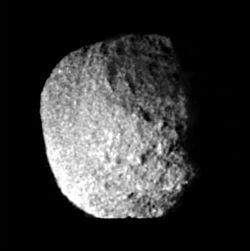புரோடியசு (நிலவு)
புரோடியசு (Proteus, /ˈproʊtiːəs/;[e] கிரேக்கம்: Πρωτεύς), அல்லது நெப்டியூன் VIII), என்பது நெப்டியூன் கோளின் இரண்டாவது பெரிய நிலவு ஆகும். 1989 ஆம் ஆண்டில் வொயேஜர் 2 விண்கலம் இதனைக் கண்டுபிடித்தது. கிரேக்கத் தொன்மவியலில் தனது உருவத்தை மாற்றும் தன்மையுள்ள கடற்கடவுளான புரோடியசின் பெயர் இந்நிலவுக்கு வைக்கப்பட்டது. புரோடியசு நெப்டியூனை அதன் நடுவரை சுற்றுப்பாதைக்குக் கிட்டவாகச் சுற்றி வருகிறது.
 |
|
கண்டுபிடிப்பு
| |
|---|---|
| கண்டுபிடித்தவர்(கள்) | வொயேஜர் 2 ஸ்டீவன் சினொட் |
| கண்டுபிடிப்பு நாள் | சூன் 16, 1989 |
| காலகட்டம்18 ஆகத்து 1989 | |
| சுற்றுப்பாதை அண்மை முனைப்புள்ளி | 117,584 ± 10 கிமீ |
| சுற்றுப்பாதை சேய்மை முனைப்புள்ளி | 117,709 ± 10 கிமீ |
| அரைப்பேரச்சு | 117,647 ± 1 கிமீ (4.75 RN) |
| மையத்தொலைத்தகவு | 0.00053 ± 0.00009 |
| சுற்றுப்பாதை வேகம் | 1.12231477 ± 0.00000002 நா |
| சராசரி சுற்றுப்பாதை வேகம் | 7.623 கிமீ/செ |
| சாய்வு | 0.524° (நெப்டியூனின் நிலநடுக் கோடு வரை) 0.026 ± 0.007° (உள்ளக இலப்பிலாசுத் தளம் வரை) |
| இது எதன் துணைக்கோள் | நெப்டியூன் |
சிறப்பியல்பு
| |
| பரிமாணங்கள் | 424×390×396 கிமீ[2][a] |
| சராசரி ஆரம் | 210 ± 7 கிமீ[5] |
| கனஅளவு | 3.4 ± 0.4 ×107கிமீ³[2] |
| நிறை | 4.4×1019 கிகி[b] |
| அடர்த்தி | ~1.3 கி/செமீ³ (அண்.)[5] |
| நிலநடுக்கோட்டு ஈர்ப்புமையம் | 0.07 மீ/செ2[c] |
| விடுபடு திசைவேகம் | 0.17 கிமீ/செ[d] |
| சுழற்சிக் காலம் | ஒத்தியங்கும் சுழற்சி[2] |
| அச்சுவழிச் சாய்வு | சுழியம்[2] |
| எதிரொளி திறன் | 0.096[5][6] |
| வெப்பநிலை | ~51 கெ சராசரி (அண்.) |
| தோற்ற ஒளிர்மை | 19.7[5] |
| பெயரெச்சங்கள் | puroodiyan |
புரோடியசின் விட்டம் கிட்டத்தட்ட 400 கிமீ இற்கும் அதிகமானதாக இருந்தாலும், இதன் மேற்பரப்பு சீரற்றதாகவும் இருண்டதாகவும், நிறமற்றதாகவும், ஆழ்ந்த குழிகளையும் கொண்டுள்ளது. இதன் பெரும் குழியின் விட்டம் 200 கிமீ இற்கும் அதிகமானதாகும். அத்துடன் பல செங்குத்துப் பாறைகளும் காணப்படுகின்றன.
படக் காட்சியகம்
தொகு-
நெப்டியூனைச் சுற்றி வரும் புரோடியசு
-
-
குறிப்புகள்
தொகு- ↑ In the earlier papers slightly different dimensions were reported. Thomas and Veverka in 1991 reported 440×416×404 km.[2][3] Croft in 1992 reported 430×424×410 km.[4] The difference is caused by the use of different sets of images and by the fact that the shape of Proteus is not described well by a triaxial ellipsoid.[2]
- ↑ The mass was calculated by multiplying the volume from Stooke (1994)[2] by the assumed density of 1,300 kg/m3. If one uses slightly larger dimensions from the earlier papers the mass will increase to 5×1019 kg.[5]
- ↑ Surface gravity derived from the mass m, the gravitational constant G and the radius r: Gm/r2.
- ↑ Escape velocity derived from the mass m, the gravitational constant G and the radius r: √2Gm/r.
- ↑ In US dictionary transcription, US dict: prō′·tē·əs.
மேற்கோள்கள்
தொகு- ↑
எஆசு:10.1086/423037 10.1086/423037
This citation will be automatically completed in the next few minutes. You can jump the queue or expand by hand - ↑ 2.0 2.1 2.2 2.3 2.4 2.5 2.6
எஆசு:10.1007/BF00572198 10.1007/BF00572198
This citation will be automatically completed in the next few minutes. You can jump the queue or expand by hand - ↑ Williams, Dr. David R. (2008-01-22). "Neptunian Satellite Fact Sheet". தேசிய வானூர்தியியல் மற்றும் விண்வெளி நிர்வாகம் (National Space Science Data Center). பார்க்கப்பட்ட நாள் 2008-12-12.
- ↑
எஆசு:10.1016/0019-1035(92)90156-2 10.1016/0019-1035(92)90156-2
This citation will be automatically completed in the next few minutes. You can jump the queue or expand by hand - ↑ 5.0 5.1 5.2 5.3 5.4 "Planetary Satellite Physical Parameters". JPL (Solar System Dynamics). 2010-10-18. பார்க்கப்பட்ட நாள் 2011-10-11.
- ↑
எஆசு:10.1016/S0019-1035(03)00002-2 10.1016/S0019-1035(03)00002-2
This citation will be automatically completed in the next few minutes. You can jump the queue or expand by hand
வெளி இணைப்புகள்
தொகு- Proteus Profile பரணிடப்பட்டது 2007-08-01 at the வந்தவழி இயந்திரம் at NASA's Solar System Exploration site
- Proteus page at The Nine Planets
- Proteus, A Moon Of Neptune on Views of the Solar System
- Ted Stryk's Proteus Page பரணிடப்பட்டது 2007-10-04 at the வந்தவழி இயந்திரம்
- Neptune's Known Satellites